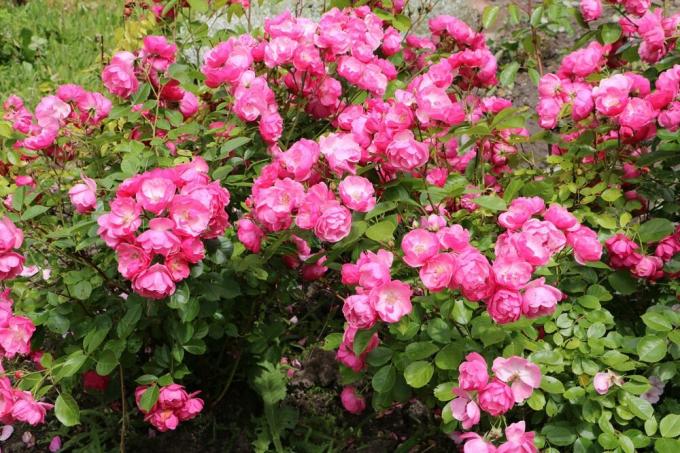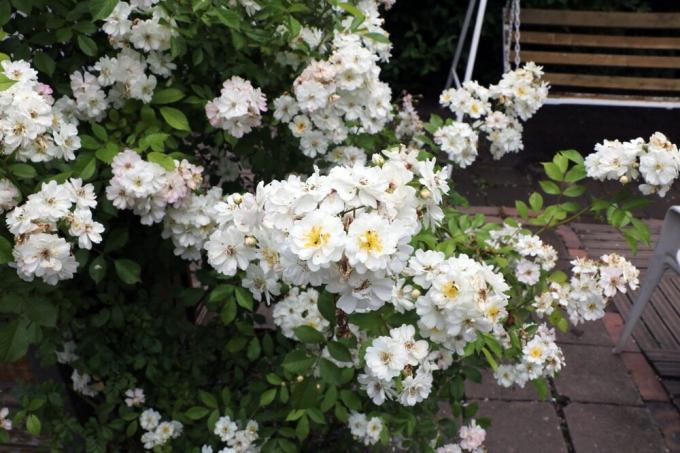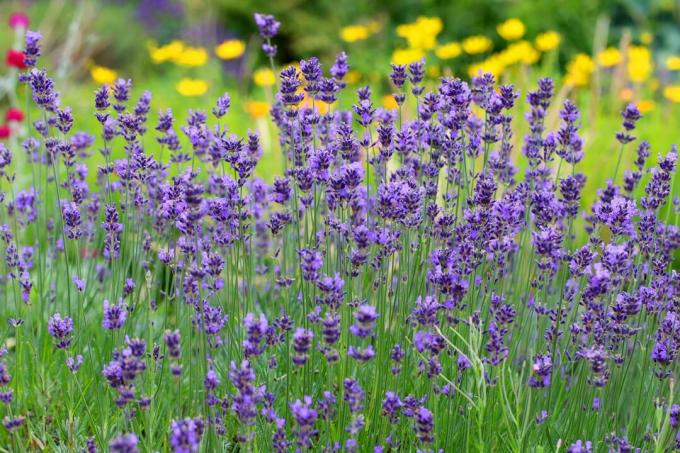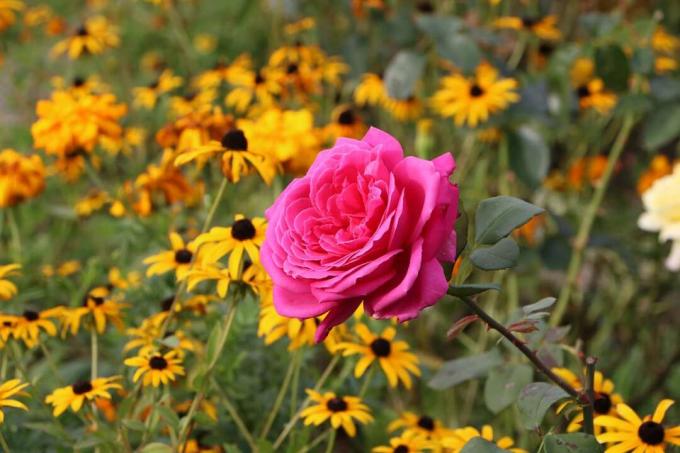

Table of contents
- Characteristics
- Plant rosettes step by step
- Select location
- Set planting time
- Prepare soil for planting
- plant bed roses
- Apply bed rose protection
- watering, if necessary also in the winter
- multiply bed roses
- Propagating roses with sticks:
- Propagating roses by cuttings
- Rose Propagation By Seeds:
Bed roses are a wonderful ornament for every home garden, even beginners can easily cope with planting bed roses. If the garden to be redesigned is very large, the question quickly arises as to how bed roses are propagated correctly. Perhaps Aunt Gerda's ancient bed rose should have a future through reproduction, or the beginner is long gone become a rose lover and connoisseur who wants to grow his own bed roses - find out how it all happens below functions:
Characteristics
- At the beginning there is the choice of location: the location should be sunny and airy
- With nutrient-rich and loose garden soil, preferably with clay content
- It is best to plant in autumn so that the rose can grow in over the winter
- In autumn, the rose is harvested in the rose nursery and can move directly to you
- Container roses can be planted all year round, but usually do not develop exemplary roots
- Plant roses in a generous planting hole, in which there is room for every fine root
- Water well and ensure sufficient soil moisture during the growth period
- After planting, the roses do not get any fertilizer
- Rather, the roots should look for nutrients and develop vigorously in the process
- If you have chosen the right variety, a bed rose is easy to cultivate
Plant rosettes step by step
Select location
Like all roses, bed roses love sunny but not too hot locations, where they are blown by a gentle breeze and where they are not too close together.
The soil should be deep, loose, humus and of medium nutrient content, pH 6.0 to 7.5 is optimal. Roses don't really make any exceptional demands on the soil, but they can be sensitive to it react to any substrate that is more or less far removed from the status of "normal garden soil". has. Therefore, if you want to plant roses, the keywords soil care, soil nutrient content, soil analysis should not Unfamiliar to you - you should know what your garden soil is like, its composition and content is ordered.
The more fertile the soil and the more airy the location, the faster the bed rose grows - but be careful, one too nutrient-rich (over-fertilized) soil is not "particularly fertile", but damages the plants that grow in it grow.
By the way, for those in a hurry who want to plant roses before they are done with the information about garden soil and its care, here are a few tips for quick soil improvement:
- Dry wet floors by mixing in sand
- Loosen compacted soils with suitable intergrowth
- Fast gardeners loosen by digging and mixing, if necessary. still loosening substances under
- Improve nutrient-poor soils by introducing fresh humus soil
Tip:
Roses thrive alongside most plants, but be aware of the local competition. A large tree very close to the rose can deprive it of nutrients, and the rose should not compete for the same topsoil with fast-growing vegetables that consume a lot.
Set planting time
The ideal time for planting roses is before the winter dormancy, from mid-October to December (depending on the climate + microclimate of the site).

Bare root roses can be stored after the fall harvest (if you do it yourself want, the gardener will tell you how to do this) and then planted from February to mid-April become.
They are then planted in spring (before that, water the dried bare-rooted roses for a day, in very warm weather shade them initially after planting). Container roses can be planted year round as long as the ground is not frozen. Potted roses are best planted in spring, as they take root better in the warmer months.
Prepare soil for planting
This is best done in the spring before planting. You can spread mature compost and/or organic fertilizer such as horn shavings (alone 50-60g per m²) and Work in topically or plant a season basic fertilizer and after planting as a mulch leave. Neither peat nor compost, manure or other (synthetic) fertilizers belong in the planting hole itself.
If roses are already growing in an actually good location, you may be concerned about putting the new roses there because you have probably heard of "rose-tired" soil. Then the following paragraph will interest you:
The mystery of soil fatigue has long been clarified: it is a normal and logical consequence of monocultural soil cultivation; every plant family uses the soil in a very specific way, extracting very specific (micro) nutrients and promotes the colonization of very specific harmful bacteria, fungi and nematodes, while suppressing others. While the details and details have not yet been clarified, the experts are clear that, especially with Rosaceae, it is not a good idea to continuously grow them one after the other in the same location.
That is why the problem of soil fatigue mainly affects rose production facilities that have soil as opposed to traditional ones Rose nurseries do not indulge in corrective crop rotation/green manure recovery, and occasionally a few home gardeners who do not know that apples, pears, strawberries, blackberries, raspberries, cherries, plums or almonds also belong to the rose family belong. The "professionals" of mass propagation use decontamination methods (which finally flatten the ground), the Hobby gardeners only need to pay attention to alternating and varied planting, then the soil always stays beautiful "awake".
plant bed roses
If a freshly harvested bare-root rose is planted in the normal way in autumn, this should be done as follows:
- Plant bare-root roses as soon as possible
- If you haven't already done so in the nursery, cut the roots by about a third, removing any damaged root parts
- The shoots have usually already adapted to the roots and do not need to be cut back
- Dig a sufficiently large planting hole
- All roots should find space without risk of damage
- Put the roses in the planting hole and align them straight from all sides
- an possibly Grafting site must be about 5 cm below the ground
- Fill the planting hole with soil, add soil after 2 days if necessary. yield earth
- When the rose is in place, water it extensively (= water it on)
Apply bed rose protection
The rose is now going into winter to form roots in peace. So that it gets some rest (also from frost and too much winter moisture), the bed rose is piled up with soil and maybe mulched with suitable garden waste, manure or compost.
Tip:
If a bare-root rose cannot be planted immediately after purchase (harvest), it can be stored in a cool place for a maximum of five days. During this time, the professionals completely immerse the roots in a bucket of water.
watering, if necessary also in the winter
After planting, you must ensure that the floribunda always has enough moisture available during the growth period. In the case of climate, this means that you have to add water even in the normally sufficiently wet autumn and winter, when exceptionally dry weather prevails for a long period of time.

Fertilization will not take place until spring next year (with organic fertilizer), until then the floribunda should stretch its roots deep into the soil in search of nutrients.
multiply bed roses
If you have planted a cultivar of a cultivar, you can try to propagate it as follows:
Propagating roses with sticks:
- Cut woody shoots of the rose in autumn or winter
- To do this, cut off the entire shoot in late autumn and remove all leaves
- The stick should be between 20 and 30 cm long
- Overwinter the cuttings in a container with moist sand in a cold, frost-free room
- When there is no longer a threat of severe frost in spring, stick sticks in prepared soil outside
- Many sticks can be placed quite close together
- When the cutting turns green and leaves, it is established
- In autumn, the young bed rose can move to its final place
- Sticks should only be stuck directly to the final location in optimal rose soil
Propagating roses by cuttings
The propagation of cuttings basically works exactly like the propagation of cuttings, but you cut the shoots as early as August (shoots that have just flowered with approx. 5 eyes) and leave the top pair of leaves standing. The prepared cuttings can be planted in pots or directly in the (very suitable) bed, thrive better under the "Mason jar greenhouse" and, in contrast to the sticks, have to be watered become.
With sticks and cuttings, you grow clones, plants that are genetically identical to the ancestor, which is usually the case with cultivated roses that are usually propagated by grafting the only possible way of propagation (they can't even grow on their own roots let alone viable offspring from seeds bring forth).
If the mother plant is not an ungrafted (growing on its own roots) rose, but a cultivar propagated by grafting, sticks and cuttings are not always your target to lead. Because the breeding specimens are not only increased through refinement, because it is faster. Another reason is that the high-bred breeding roses can often no longer form strong and viable roots.
Here you have another safe way of rose propagation: Cut cuttings/sticks from a side shoot of the rootstock, they actually always form roots. Unfortunately, this path has the "small disadvantage" that there is no new one from the 'Fleur ordonné de Béotien' 'Fleur ordonné' arises, but a small, wild and untidy growing rose of the Wildlings rootstock "XY". Which isn't necessarily a problem for people who also love "plants developed by nature".
Tip:
If you buy neither wild roses nor original varieties directly from the rose breeder, you should go to the When purchasing cultivated roses, be sure to check whether a particular variety of rose has received an award has. For example, an ADR predicate, with which the working group "General German Rose Novelty Test" (ADR) evaluates the garden value of rose novelties. Since the breeding roses are now very susceptible, the test is no longer primarily about beauty, flowering, scent (as with previous awards), but the Resistance to leaf diseases is the most important evaluation criterion (which in these modern cultivars contributes more to the survival of the rose at the buyer's than all Care).
Rose Propagation By Seeds:
Perhaps you have one of the very old, still very original cultivars of bed roses (or even a wild rose) placed in the bed, the rose hips after flowering and seeds in these rose hips trains. Then you can go among the rose growers and propagate your bed roses as it happens in nature:
- Gather the ripe rose hips in the fall
- Extract the rose seeds from the rose hips
- Soak the seeds in water for a few days, the viable seeds will sink to the bottom
- They are now kept in the fridge at approx. 4 °C stratified for one month
- Then you can sow in lean potting soil, approx. 1 cm deep
- Keep seeds cool and moist until they begin to germinate
- Then the cultivation vessel moves to a bright, moderately warm place without bright sun
- When they have 4-6 leaves, the roses are placed individually in pots with nutrient-rich garden soil
- And wintered in this condition cool, bright, frost-free
- The young rose can be planted in the garden next spring (when no more frost is expected).
- The alternative is direct sowing in the fall, but you don't have the same degree of control over the offspring
When you're propagating roses from seed, there's always a chance you'll end up with a few failures. It's not up to you, and it shouldn't bother you. That's how plant breeding works: offspring with slightly altered genes, most of which cope with the environment about as well as the parents. Some evolve a little better (breeding continues with them) and some have to be written off as "victims of evolution".
 garden editorial
garden editorial I write about everything that interests me in my garden.
Learn more about bed roses

Cut bed roses and standard roses - instructions
In order for beautiful bed roses to show their most beautiful side over the long term, they must be pruned regularly. The instructions in the article tell you how to correctly prune bed roses and standard roses.

Bed roses - varieties and care instructions
Bed roses are probably the most beautiful guarantee for lush blooms and color in the garden bed. In the article you will learn why there are almost countless varieties of bed roses and how these varieties should be cared for.

What goes with roses: 30 beautiful rose companions
The beauty of roses really comes into its own when surrounded by the right companion plants. It is important for rose companions that they have similar requirements to roses. We tell you what goes well with roses.

These 15 Flowers Are Hardy & Perennial | bedding plants
Unlike annual flowering plants, perennials come back every year. They stay in one place for many years and play a major role in garden design. Some varieties get through the winter without any problems. We introduce you to 15 hardy perennials.

You can combine lavender with these 13 plants
Whether you use it in the kitchen, want to enjoy its fragrance or its beauty, lavender is a must in any garden. Well combined, it can strengthen other plants or protect them from pests. We present the best plant neighbors.

Rose soil: mix soil for roses yourself | composition
The rose is considered the queen of flowers and she is very demanding. When it is newly planted, the soil should therefore be optimally prepared. Special rose soils are particularly suitable for planting. How to make them yourself is in this post.



